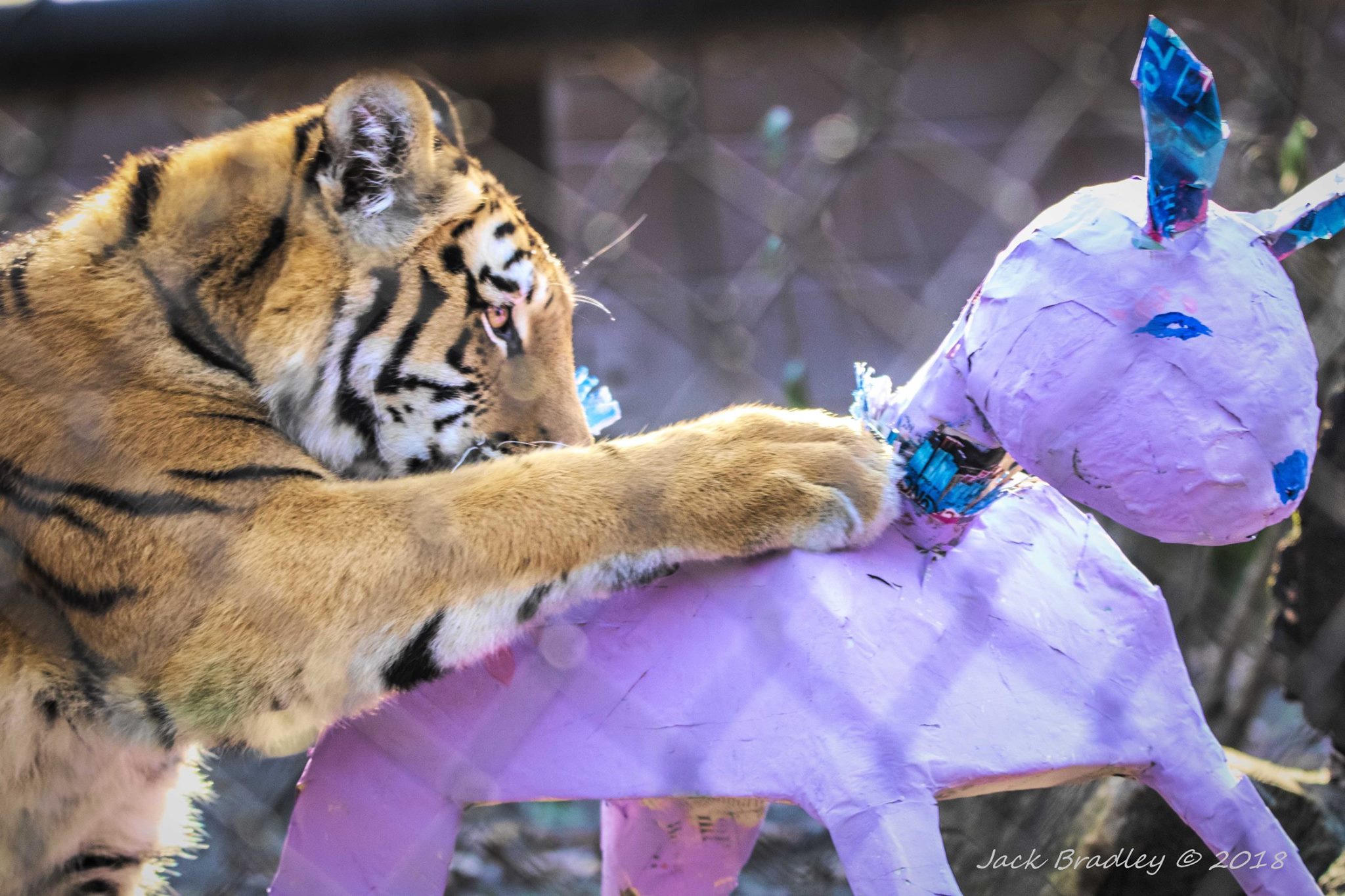
BRIDGEPORT, Conn. – Connecticut’s Beardsley Zoo’s fundraising efforts to create a new habitat for its family of Amur tigers received a huge boost with a $1,000,000 donation from longtime Zoo supporter Pamela Hope Kochiss-Werth. After the birth of four extremely endangered Amur tiger cubs in November 2017, two of which survived, the Zoo began a campaign to create a new, more spacious home for its valuable tigers. Pamela Kochiss-Werth stepped forward with a birthday check for the two female tigers, Reka and Zeya, earmarked for a new tiger habitat.
“The existing tiger habitat was built several decades ago and has been on our wish list to expand and renovate. Our intention is to create a habitat more in keeping with 21stcentury accredited zoo standards,” said Dancho. “We are overwhelmed with gratitude at Pam’s extreme generosity. Zoos today serve as Noah’s Arks for endangered species, offering both a place of sanctuary and a Species Survival Plan to ensure that the species doesn’t vanish. Pam’s donation ensures that we can continue our important species saving work, with our focus on animal welfare.”
“The Zoo is asking for matching donations,” he added. “Everyone has an opportunity now to help. There’s no donation too small.”
The tiger cubs’ first birthday was celebrated on Sunday, November 25th, with the sale of Team Reka, Team Zeya, or Team Tiger Cubs t-shirts, cake and hot chocolate for Zoo guests, free tiger bookmarks for the first 500 people through the gate that day, and two encore presentations of Fostering Felines, a presentation from Animal Care Specialist Bethany Thatcher. Tiger Talks, highlighting the plight of Amur tigers in the wild, were held in front of the habitat throughout the day. Members of Pamela’s Kochiss’s family were the day’s Guests of Honor.
Both Pam and Deb Bachard, through the Werth Family Foundation, have repeatedly supported the Zoo through generous grants. Some of the programs they have underwritten include the Amur Leopard Habitat, the Seasonal Country Fair Exhibit, and Zoo Educational Programs. “Animal welfare and species survival are causes very close to my heart,” said Pam. “Our gifts to the Zoo are designed to promote conservation and education, while enriching family and community recreational experiences.”
This is the first grant made by Pamela Hope Kochiss-Werth’s new foundation, and reflects her individual philanthropy. “As a Bridgeport native, I have many fond memories as far back as 1958, of enjoying wonderful times with my family at Beardsley Park and the Zoo,” she said. “I feel honored and blessed to be able to contribute to the Zoo’s growth, important programs, and life-enriching contributions to Bridgeport and all Connecticut communities. The Zoo’s impact on enhancing quality of life in Bridgeport, along with Connecticut tourism and economic development is an added plus. And I have a soft spot for those magnificent big cats!”
When the tiger cubs were born, they had only a 25% chance of survival, and were the only two Amur cubs added to the AZA’s Amur tiger population in 2017. Reka and Zeya’s first birthday is cause for celebration, and an important step forward in maintaining the genetic diversity of Amur tigers worldwide.According to the Association of Zoos and Aquariums’ (AZA) statistics, tigers are thought to occupy less than seven percent of their original range. Threatened by habitat loss and degradation, poaching, tiger-human conflict, and loss of prey, four of nine subspecies have disappeared from the wild. The future of the Amur tiger has been a major concern of the world’s zoos for many years.
All tigers now have protected status in the wild, but that doesn’t guarantee their safety. A breeding program recommendation comes from the Species Survival Plan (SSP), administered by the Association of Zoos and Aquariums in accredited zoos. Connecticut’s Beardsley Zoo was home to the parents, a male, Petya, and a female, Changbai, who joined the Zoo family last winter. Managed by the SSP, inter-regional transfers are arranged with careful attention to gene diversity in the hope that successful breeding will take place. Chang was sent to Connecticut’s Beardsley Zoo as an excellent genetic match to the Zoo’s resident male tiger, who has since been transferred to another zoo.
About Amur tigers
The Amur, or Siberian tiger, is a rare subspecies of tiger, and the largest cat in the world. Adult male tigers can weigh up to 675 pounds, with females weighing up to 350 pounds. Chang is small for a female Amur tiger, weighing 297 pounds. Reka and Zeya weigh approximately 180 pounds each, but they will continue to grow. Similar to people’s fingerprints, no two tigers have the same striped pattern. Amur tigers differ from other tigers with fewer, paler stripes, and a mane that helps to keep them warm. They live in southeast Russia as well as small areas of China and North Korea. They live for 10-15 years in the wild, and up to 22 years in captivity.
About Connecticut’s Beardsley Zoo
Spend the day a world away! Connecticut's only zoo, celebrating its 96thanniversary this year, features 300 animals representing primarily North and South American species. Guests won't want to miss our Amur (Siberian) tiger family, Amur leopards, Maned wolf family, Brazilian ocelot, Mexican wolves, Red wolves, and Golden Lion tamarins. Other highlights include the new Natt Family Red Panda Habitat, the South American rainforest with free-flight aviary, the prairie dog exhibit with "pop-up" viewing areas, the New England Farmyard with goats, pigs, and other barnyard critters, plus the hoofstock trail featuring bison, deer, and more. Guests can grab a bite at the Peacock Café, eat in the Picnic Grove, and enjoy a ride on our colorful, indoor carousel. For more information, visit beardsleyzoo.org.